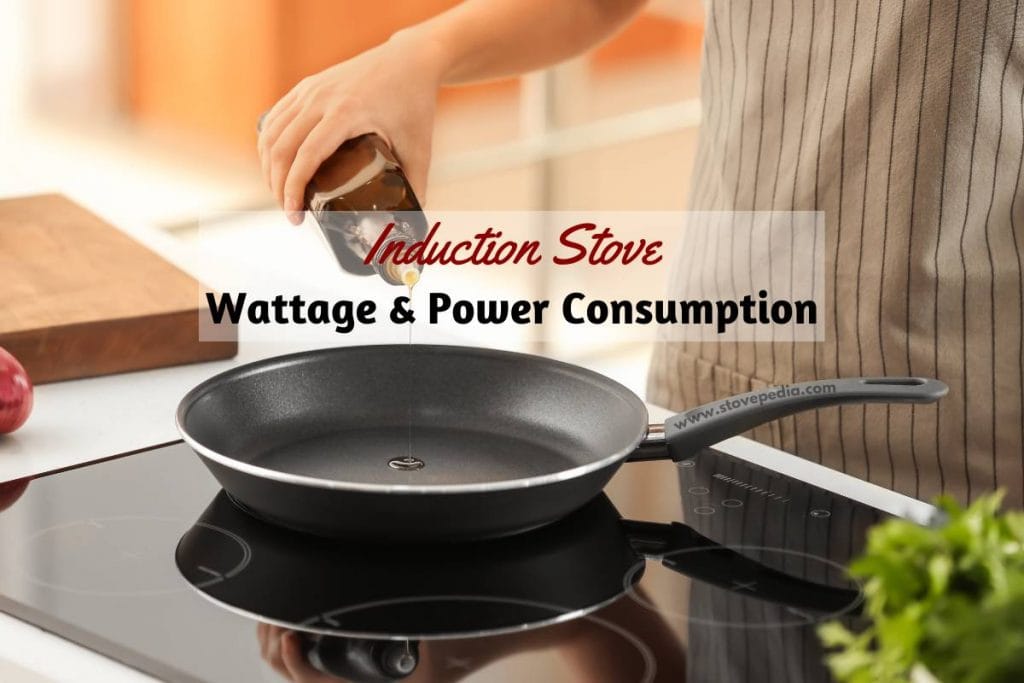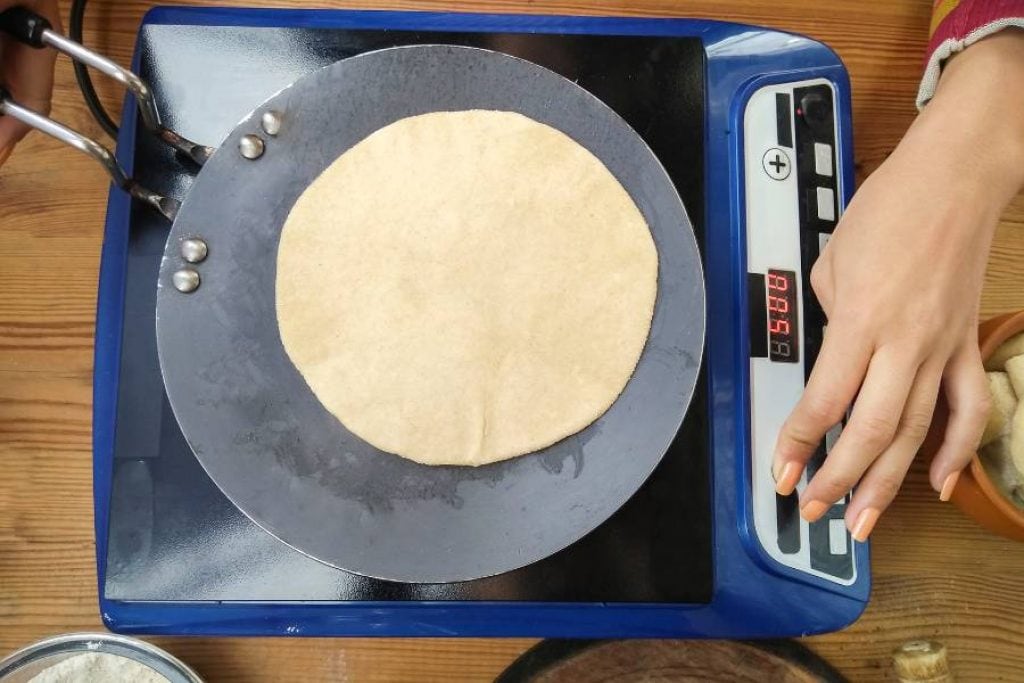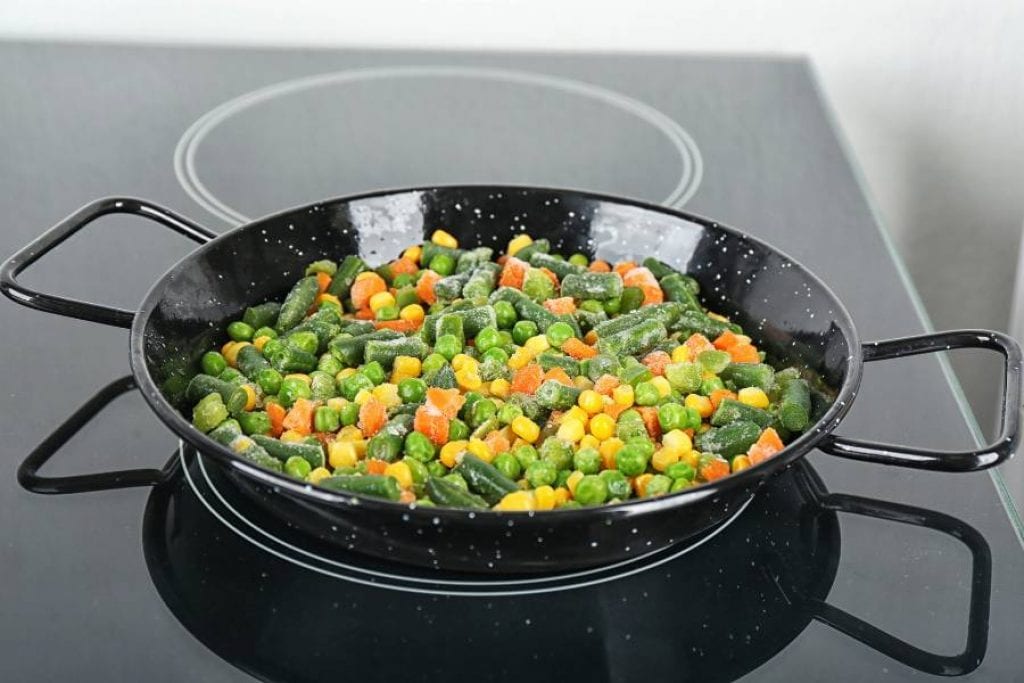There are two main reasons why many people are switching to induction stoves– faster cooking and energy efficiency. Induction cooktops are 80% efficient, which is 20-30% more than gas or electric stoves.
This means reduced energy consumption and also big savings on the monthly bill. As I have experienced as a chef in various restaurants, inductions also cook food faster, which adds to the reduced usage of electricity.
But how much power does an induction stove actually consume? How many watts does a induction stove use?
While the energy efficiency is important for induction cooking, knowing the wattage and electricity usage will help you choose the right cooktop or optimize the correct settings on your existing one.
In this article, I will discuss in depth about the significance of wattage, how you can calculate power consumption and electricity bill for induction cooking. If you want to know the induction stove power consumption in units, our calculator is the best tool available online.

How Much Electricity Does An Induction Stove Consume?
The electricity consumption of induction stoves can be understood from the rated wattage. Typically, this falls between 1000 to 2500 watts which means induction cookers have a higher wattage when compared to most household appliances. But a higher wattage doesn’t necessarily mean that the appliance contributes more to your electricity bill.
As induction stoves are highly efficient, they require less time to cook food compared to gas stoves. A cooktop with lower wattage will consume less power but take up more time, whereas a higher-wattage induction stove consumes more power for less time. To understand how it changes energy consumption, you must first understand some basic terms.
Recommended Induction Cooktops With Best Wattage
Key Terms Related To Power Consumption
When you are studying the wattage or power consumption of an induction stove, these are a few terms that pop up frequently.
Watts (W)
Watt is the unit of power and is defined as the rate of energy consumed by any device, here the induction stovetop. If the rate of energy consumption of your induction stove is defined as 1500 watts, then it consumes 1500 watts of electricity every hour.
Kilowatts (kW)
Kilowatt is also a unit of power used to express higher electricity usage. One kilowatt is equal to 1000 watts. The energy consumption of a 2000-watt device can also be written as 2 kilowatts. Similarly, we can also use megawatts (1000 kW) and gigawatts (1000 MW). However, the wattage of induction stoves is limited to a few kilowatts.
Kilowatt-hour (kW-h)
Kilowatt-hour is usually misunderstood as the number of kilowatts used per hour. But it actually measures the consumption of energy equivalent to one kilowatt of energy per hour. The main difference between a kilowatt and a kilowatt-hour is that kilowatt measures power or the rate of energy consumption, whereas a kilowatt hour measures the total energy or the amount of energy consumed.
A 2 kW induction stove consumes 2 kilowatts of energy every hour. And the same device will take 30 minutes to reach 1 kWh. Similarly, a 200-watt device will consume 200 watts of energy every hour. But it will take 5 hours to use 1kWh of energy. Usually, the monthly electricity bill records the electricity usage in kWh.
Electricity Tariff
It is the price of one unit (1 kWh) of electricity in your area. The electricity tariff multiplied by the number of units consumed gives the total electricity bill every month.
Now that you understand what these terms mean, you can easily calculate the electricity usage of the induction stove.
Range Of Wattage For Induction Stove
The range of wattage for household induction stovetops is around 800-3000 W. But this doesn’t mean that the appliance will always consume power equal to its wattage.
For example, a 1500 W induction cooktop has an upper limit of 1500 W at its higher power mode. You can still use it at lower power modes such as 500 W, 750 W, and so on.
The best wattage for an induction cooktop is high as 2000 Watts, as you can set different power modes depending on what you are cooking. Higher wattage involves generation of a high amount of heat in the shortest time, resulting in faster cooking and lower power consumption.
Here is a table comparing different power modes, wattage, temperature and uses.
| Power Mode | Wattage | Temperature | Uses |
|---|---|---|---|
| 1-2 | 500-800 W | 35-65oC | Reheating, Defrosting, Warming Milk and Water |
| 3-4 | 800-1200 W | 80-100oC | Slow Cooking, Boiling Milk |
| 5-6 | 1000-1400 W | 120-150oC | Saute Meat and Vegetables |
| 7-8 | 1400-1800 W | 180-230oC | Deep Frying |
| 9-10 | 1800-2200 W | 275-325oC | Searing and Browning Meat |
Apart from this, most induction stoves have preset cooking menus. These menus set the optimal time and cooking temperature for that particular function, so you don’t need to monitor it constantly.

How To Calculate Power Consumption And Electricity Cost For Induction Stoves?
The wattage may give a rough idea about the electricity your induction stove uses. But it isn’t the only factor that decides how much it costs to use the cooktop. For a more precise idea, it is better to calculate the electricity usage based on personal usage.
You can easily calculate the power consumption of your induction cooker by knowing its wattage and total operational hours every day.
First, you need to calculate the units of electricity your appliance consumes every day by multiplying the wattage by the operational hours.
kWh = (Wattage * Number of hours) / 1000
Then, multiply the number of units by the electricity tariff and the number of days in the month to calculate the total contribution of the induction stove to your monthly bill.
Electricity bill = kWh x Tariff x 30
Using this monthly electricity consumption and bill, you can calculate the yearly figures.
Example Of Power Consumption Calculation
To understand better, you can refer to this example. Consider a 1500 W induction stove being used for 4 hours every day. Then the units of electricity it consumes per day are given by,
1500 x 4/1000 = 6 kWh
Now, consider the tariff in the area to be ₹10 per unit of electricity. Then the total cost of running the induction stovetop every month will be,
6 kWh x 10 x 30 = ₹1800
Similarly, the total charge every year will be
6 kWh x 10 x 365 = ₹21900
However, this is only the upper limit of cost from the induction stove every year, considering 100% efficiency. But, in reality, you can achieve 80-90% efficiency. In such a condition, the energy usage and corresponding electricity cost will increase about 10-20%.
Induction Stove Power Consumption Calculator
This induction cooktop power consumption calculator is a useful tool to calculate used energy and electricity bill by an induction cooktop from the wattage, the duration of usage, electricity tariff and efficiency.
1200 W Vs 1800 W Vs 2000 W Induction Cooktop
The power consumption of induction cooktops with different wattages might also vary. This means a 1200W induction cooktop will impact your electricity bill differently than a 2000 W cooktop. For better understanding, I have made a comparison of 1200 W vs. 1800 W vs. 2000 W induction stoves.
The Assumptions And Considerations
- The calculation involves boiling 1 liter of water at 100°C.
- Higher wattage reduces cooking time and vice versa.
- No thermal or electrical energy loss is considered as they vary for different models.
- Electricity tariff ₹10 per unit.
Now, let’s check the comparative calculation for power consumption and electricity bill for 1200, 1800 and 2000 watts induction stoves.
1200 W Induction Stove
As the cooktop is of low wattage, it requires more time to generate heat. So, it may take around 10 minutes to boil a liter of water. We can calculate the total units of electricity consumed by:
10 x 1200/60 = 200 W or 0.2 kWh
At ₹10 per unit, 0.2 x 10 = ₹2
So, a 1200 W induction stove will cost ₹2 to boil a liter of water.
1800 W Induction Stove
This 1800 W cooktop has higher wattage than the previous 1200 W one, so it will take less time, say 8 minutes to boil a liter of water. The total units of electricity consumed in this case are:
6 x 1800/60= 180 W or 0.18 kWh
At ₹10 per unit, 0.18 x 10 = ₹1.8
An 1800 W induction cooktop uses electricity worth ₹1.8 to boil a liter of water.
2000 W Induction Stove
It has the highest wattage and requires the least time to generate enough heat. Considering 4 minutes to boil one liter of water, the power consumption calculation is-
4 x 2000/ 60= 133.33 W or 0.13 kWh
At ₹10 per unit, 0.13 x 10 = ₹1.3
A 2000 W induction cooker costs only ₹1.3 to boil a liter of water.
You can compare the three cooktops using the below table for boiling 1 liter of water everyday for a month.
| Wattage | Monthly Power Consumption | Monthly Electricity Bill |
| 1200 Watts | 6 kWh | ₹60 |
| 1800 Watts | 5.4 kWh | ₹54 |
| 2000 Watts | 3.9 kWh | ₹39 |
So, with increased wattage, cooking needs less time, saving more electricity. This means you ultimately end up saving more with a 2000 W cooktop than with a 1200 W.

Why Is Induction Cooking Beneficial?
When compared to gas stoves, induction cooking has several benefits with regard to energy efficiency and operational costs.
- High Efficiency: When you use gas stoves, the flame transfers heat through radiation and conduction. This means that some amount of heat is lost to the surroundings and the fuel usage efficiency isn’t high. But, induction cooking involves electromagnetic induction to generate heat directly in utensils. As there is no heat transfer, there is a low scope of energy loss, making induction cooking 80-90% energy efficient.
- Reduced Cooking Time: Due to higher wattage and efficiency, induction cooking require less time than gas stoves to cook food. They are also better at temperature regulation, so you can maintain a constantly high or low temperature while cooking.
- Improved Safety: Induction stoves don’t heat up on their own and always need induction cookware to generate heat. If you accidentally switch on the induction cooker, the top surface won’t be heated if it is left empty. This means no more stove-related burns and injuries in the kitchen. It is also much safer when children are around. Induction cooking involves an auto-shut-off option that shuts down the power supply if the temperature is too high or there is no utensil on the cooktop. This ensures the safety and prevents kitchen accidents.
- Reduced Costs: With rising LPG prices, induction cooking is definitely more cost-effective. Not only do they use a small amount of electricity, but the quick cooking and high efficiency all add up to save costs.
- Eco-friendly: Gas stoves release carbon monoxide and other toxic gasses into the atmosphere. It can be harmful to you, your family, and your pets. But induction stoves don’t burn fuel and cause no pollution. Though they are usually powered by electricity generated by burning fossil fuel, you can also connect them to renewable energy sources like solar power. Thus induction cooking is not only better for the earth but also for your health.
- Versatility: While ferromagnetic materials are essential for induction cookware, such cookware can also be used on gas stoves. In case of power-cuts, you can quickly switch cooking to your gas stove.
Limitations Of Induction Cooking
- Power Related Problems: If you are in an area with frequent power cuts, then induction cooking might be a problem. Induction stoves require a continuous power supply when in use. With frequent power cuts or low voltage conditions, they are not reliable.
- Effect Of Voltage Fluctuations: You need to ensure a stable power supply for induction cooking. If you face a lot of fluctuations, then the electricity usage of the stove may vary, resulting in uneven heating or damage to internal parts. It is best to use a stabilizer with induction cooktops.
Tips For Saving Electricity And Money With Induction Stoves
Identify Your Cooking Requirements
Induction cooktops with a higher wattage may seem like the go-to option due to higher cost savings. But such stoves are also more expensive. If you plan to use it occasionally, then a lower-wattage cooktop is more suitable. Opt for a higher wattage for regular usage.
Use The Right Mode and Wattage
Induction stoves have several power modes which give you better temperature control by adjusting the wattage. Choose the right temperature when you are cooking so you can save more energy. Also, try to use special modes as they are designed to provide the optimal heat for that purpose.
Always Use Induction Cookware
While non-ferromagnetic cookware doesn’t work on induction stoves, there are tools such as induction plates that allow you to use this cookware. However, they are not energy efficient, resulting in uneven heating, delayed cooking, and increased operational costs. Thus, always choose ferromagnetic induction cookware to get the maximum energy efficiency for cooking.
Opt For Professional Repairs
If your induction stovetop is old or has any issues, refrain from self-repairing. Getting help from company-assigned technicians will help you lower the recurring maintenance cost for long term. This will save you from misconfiguration and faulty repairs that can increase the repair and replacement cost.
The Conclusion
Induction cooktops have varying power consumptions that serve different purposes. A higher-wattage cooktop has lower operational costs. But you should choose a suitable stove depending on your cooking requirements. Considering the hours of usage and the type of cooking will help you choose the best wattage for your induction stove.


On my old Electrolux stove from 1984, I can cook potatoes when the plate is set to 2 (160 watts) after the water has boiled, which takes about 5 minutes when set to 6 (1500 watts). Potatoes cook in approximately 20-30 minutes. I’m curious about how an induction cooker cooks potatoes. As far as I understand, water boils in about 1 minute on induction (1500 watts), but it continues to use about 1000 watts to sustain boiling for 20-30 minutes. Does this mean induction cooking isn’t more cost-effective than the old cast iron cooker from 1984?
Induction cookers are indeed known for their efficiency, as they can rapidly heat up and cook food. However, the cost-effectiveness can vary depending on factors like electricity rates and the specific model of the cooker. It might be worth considering a modern induction cooker with energy-saving features if you’re looking to upgrade for efficiency.
Wow I am totally new to induction appliances. Your guidance was exceptional and easy to understand. It clarified so many things to me. Thank you for taking the time to create the post.
I am glad to help you out!
Hi, thanks for shearing the valuable information. My doubts are clear now. Nice article.
You’re most welcome!